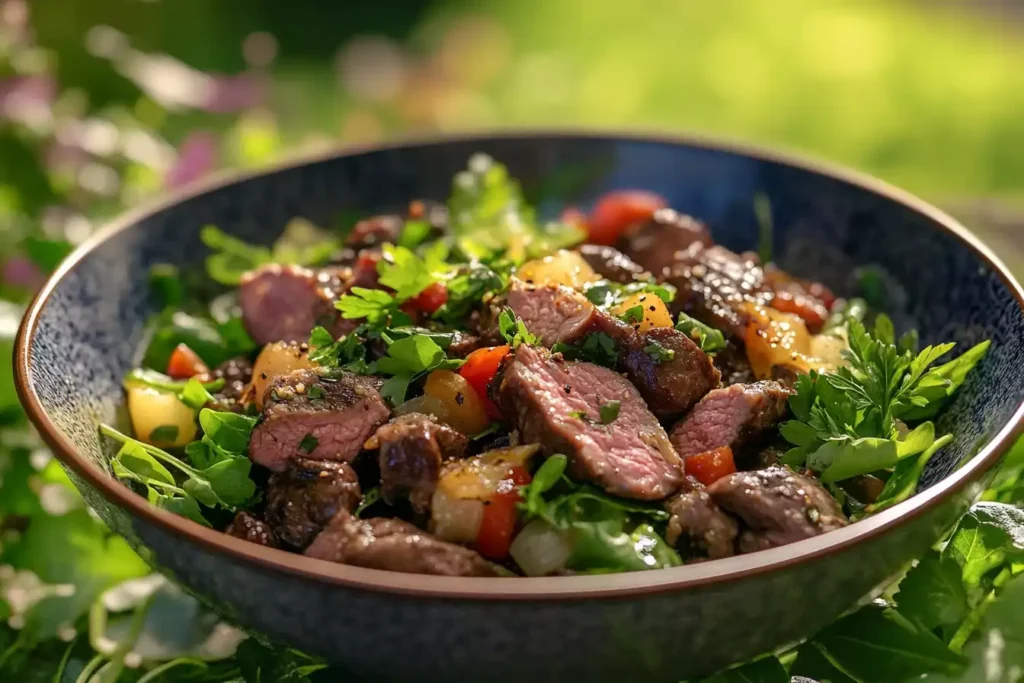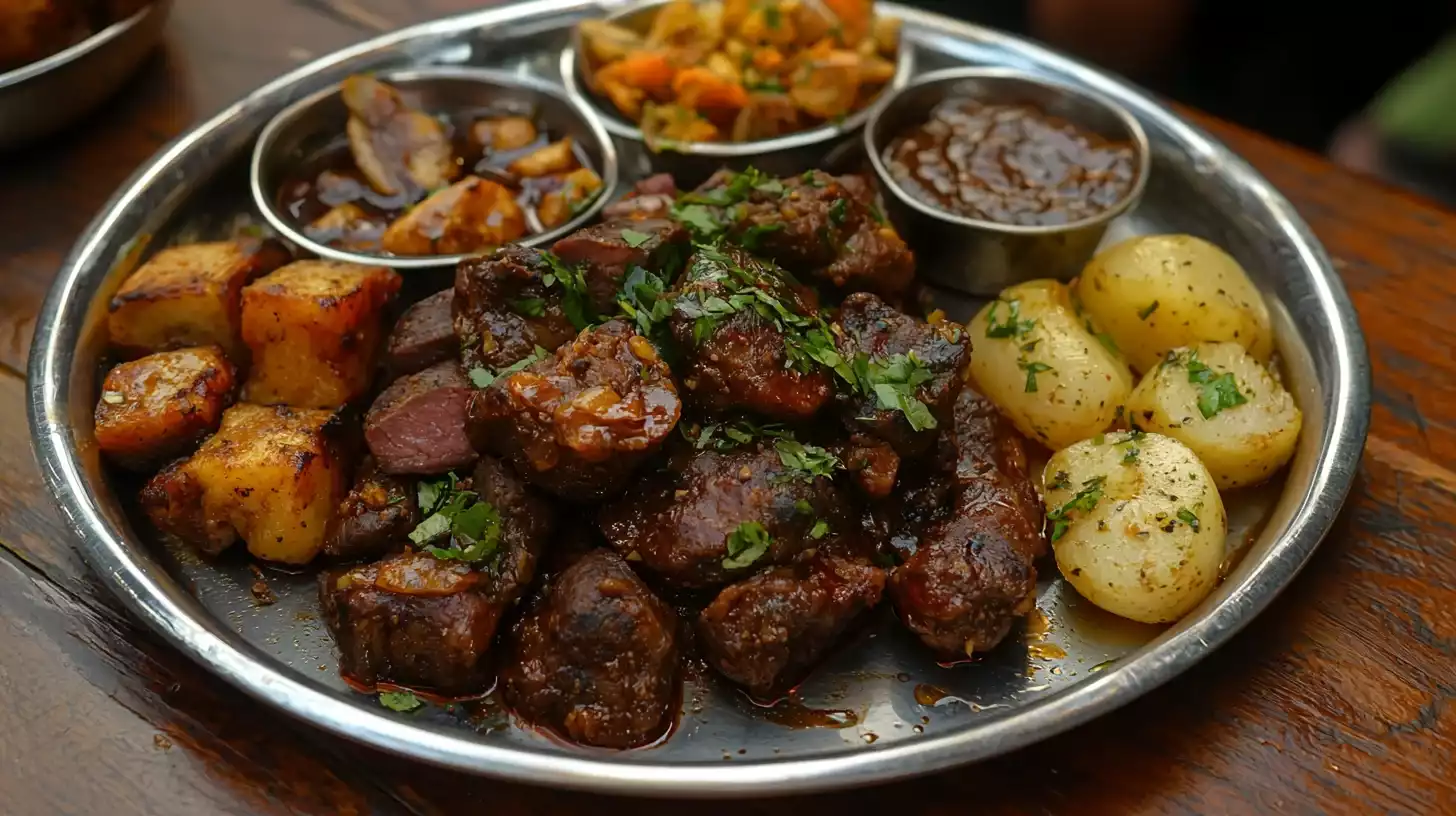Organ meats, often overlooked in modern Western diets, hold a world of flavor and nutritional benefits. Today, we delve into the intriguing world of the beef spleen. So, what does beef spleen taste like? It is a question that piques the curiosity of adventurous eaters and those seeking to explore traditional culinary practices. If you’ve ever wondered about the taste, texture, and culinary applications of this unique cut, you’ve come to the right place. We’ll guide you through everything you need to know about beef spleen, from its unique taste to ways you can prepare it.
Table of Contents
What Exactly is Beef Spleen?
Before we dive into the taste, let’s understand what we’re dealing with. The beef spleen is an organ located near the stomach in the cow’s abdominal cavity. It’s a dark red, somewhat oval-shaped organ, often ranging in size. Its primary function in the animal is to filter blood and aid the immune system. Unlike other organ meats like the liver or heart, the spleen has a different consistency and flavor profile that sets it apart. The texture, unlike the smooth liver, is often described as having a slightly grainy feel.
What Does Beef Spleen Taste Like? The Surprising Taste of Beef Spleen: A Detailed Breakdown

The taste of beef spleen is quite unique and may not be what you expect from a piece of meat. The beef spleen flavor is often described as having a slightly gamey note, which some might also describe as “earthy”. Many detect a distinct iron-rich taste, which is due to the spleen’s role in blood filtration. Think of a mild metallic undertone rather than something overwhelmingly strong. The initial flavor might be delicate, but there’s a lingering savory characteristic that’s hard to ignore. Its flavor is not overpowering, but rather subtle, demanding your attention and exploration. This subtlety is what makes it an interesting ingredient for various cuisines.
The texture is another aspect that defines the beef spleen experience. When raw, it has a smooth yet slightly grainy feel, almost like a soft sponge. When cooked, it can become tender or slightly firmer, depending on the method. Braising or stewing tends to make it very soft and yielding, whereas frying or grilling can give it a slightly chewier texture. The key to a pleasant texture lies in the preparation and cooking process. The final taste of beef spleen is significantly influenced by a variety of factors.
An animal’s diet has a strong impact: cows fed on lush pastures might yield a spleen with a milder, cleaner taste, while an animal on a standard diet might produce a spleen with a stronger flavor. The age of the animal also influences its flavor profile, typically, younger animals will have a milder taste, compared to the older ones, whose flavor tend to be more pronounced.
When comparing beef spleen to other organ meats, it is essential to understand the differences. Unlike the beef liver, which has a distinctly strong, somewhat bitter flavor, the spleen is milder and less intense. It doesn’t have the richness of the heart or the intensity of the kidneys. Instead, it offers a unique taste that’s both savory and subtly metallic. While some may find the organ meats similar, the spleen carves a unique spot.
How to Prepare Beef Spleen for Optimal Flavor

Proper preparation is crucial when working with beef spleen. Start by cleaning it thoroughly under cold running water. Carefully remove any outer membrane, fat, or connective tissue with a sharp knife. This step helps to achieve a smoother texture and removes unwanted impurities. You can cut the spleen into smaller pieces for easier cooking. Once cleaned, you can proceed with your chosen method.
There are various methods to cook beef spleen. One of the most popular methods is braising, which involves slow-cooking the spleen in liquid at low temperature. This technique breaks down the connective tissue and creates a super tender result. This method not only tenderizes the meat but also allows the spleen to absorb all the flavors of the braising liquid. Frying or sautéing is another option.
Simply slice the spleen into thin strips, season them generously, and pan-fry them until they are golden brown. This approach results in a crisp exterior and a tender interior, a perfect combination of textures. Grilling can impart a smoky flavor to the spleen that gives a unique and delicious taste. No matter your chosen cooking method, always ensure the spleen is cooked thoroughly to a safe internal temperature.
To get the maximum flavor out of your beef spleen, use some good complementary flavors, herbs, and spices. Garlic and onions form an excellent base for any spleen dish. The aromatic notes of garlic and the mild sweetness of onions will enhance the natural flavors of the beef spleen. Add a pinch of paprika, which will also contribute a smoky aroma. A few sprigs of thyme or rosemary can add a fragrant touch. A squeeze of lemon juice at the end can brighten the taste and reduce any gaminess. These simple seasonings are crucial for highlighting the beef spleen taste while mitigating some of the stronger notes.
The Nutritional Powerhouse: Benefits of Eating Beef Spleen
Beef spleen is more than just an intriguing taste experience, it is a nutritional powerhouse. This underrated organ is full of essential vitamins and minerals that can be highly beneficial to your health. Beef spleen is an outstanding source of iron, which is essential for carrying oxygen in your blood and preventing anemia. Consuming iron-rich foods can also boost your energy levels and reduce fatigue.
Beef spleen is also rich in vitamin B12, a critical nutrient for nerve function, DNA synthesis, and red blood cell formation. B12 deficiency can lead to neurological issues, so it’s vital to have an adequate intake. Additionally, the spleen provides a good amount of riboflavin, also known as vitamin B2, essential for energy production, cell function, and metabolism. Beef spleen includes several minerals like zinc, which helps the immune system, and selenium, which acts as a strong antioxidant. It’s important to eat a variety of foods to get all the nutrients your body needs, and beef spleen provides a unique blend.
It’s important to mention some points to consider when planning on adding beef spleen to your diet. Spleen is high in cholesterol. If you have elevated cholesterol, you may need to monitor your consumption. As with any food, allergies or individual sensitivities may occur. If you have an unusual reaction after eating spleen, stop eating it and seek professional help if necessary. Always purchase organ meats from a reputable source. Always cook thoroughly to eliminate potential bacteria. When consumed in moderation, beef spleen can provide a range of health benefits because of its nutritional value.
Tips and Tricks for Cooking Beef Spleen
Cooking beef spleen can be tricky for beginners, but there are some tried and tested tips to get it right. The key to the perfect cooked spleen texture is avoiding that rubbery or tough outcome. Start by carefully removing any excess tissue and sinew. Cut the spleen into uniform pieces. This will ensure even cooking. When braising, be sure to slow cook at low temperatures to make the meat more tender. In case you choose to pan-fry it, cook it in batches to avoid overcrowding the pan. Overcrowding will lower the temperature of the pan and prevent proper crisping.
Enhancing the flavor of beef spleen can be done with marination. A marinade of garlic, herbs, lemon juice, and olive oil can really amplify the existing flavors and make them pop. Another method is brining the meat before cooking, this will tenderize the meat and reduce the strong taste. Experiment with different spices, such as cumin, coriander, or smoked paprika to add depth to the flavor. Searing the meat on high heat before braising or stewing will create a flavorful crust.
If you are not a big fan of the strong flavors of organ meat, do not worry, you can manage to reduce them. A simple method is to soak the spleen in milk or salted water for a couple of hours. This will help draw out some of the stronger elements. Another trick is to boil the meat for a couple of minutes and discarding the water. Add acidic components like lemon juice or vinegar during the cooking process to tone down the strong flavors. You can also serve the spleen with strong, flavorful sauces or vegetables, which will neutralize its taste.
Beef spleen, although not considered a popular dish, can be included in your meal using innovative and creative ways. You can use a pan-fried spleen in a taco or put some slices on top of a salad to boost your iron intake. Spleen can be finely chopped to make a pate or served as part of charcuterie. This will not only add to the complexity of flavors but also bring new textures and tastes to your dish. Serve it with a side of roasted vegetables, polenta or mashed potatoes to create a complete meal.
Common Culinary Uses of Beef Spleen Across The Globe
Around the world, beef spleen is a staple in various regional dishes. For example, in some parts of Europe, spleen is used in traditional stews and soups. The slow cooking methods used allow it to tenderize and impart a deep flavor to the dish. One famous dish is known in the Southern parts of Italy, where the spleen is slowly braised with herbs and vegetables. This dish is the prime example of how the beef spleen can be transformed with the right ingredients and techniques.
In Asian cuisines, beef spleen is featured in many unique dishes. In some traditional Chinese cuisine, the spleen is stir-fried with garlic, ginger, and soy sauce, which is a perfect example of a balance of flavor and texture. The unique techniques used in Asian dishes highlight the spleen’s ability to absorb flavors and bring a unique element to each dish.
Beef spleen also finds its way into modern cuisine. Chefs all over the world are starting to use less commonly eaten cuts of meat and are creating innovative dishes. You can add finely chopped spleen to burgers or meatballs for an extra boost of nutrients and flavor. Spleen can also be dehydrated, powdered, and used as seasoning to add a unique flavor to various savory dishes. Its adaptability makes it a very interesting option for the experimental cook.
When serving dishes made with beef spleen, choosing a drink that complements the flavor profile can greatly improve your overall experience. When eating rich, savory spleen, a full-bodied red wine will pair perfectly with it. The tannins in the wine will cut through the richness of the meat and create a balanced combination. For a lighter option, try a dry rosé which adds brightness and acidity. You can also pair the dishes with a refreshing beer such as a light lager or a crisp ale, which will provide a good contrast to the spleen. The key to perfect pairing is to choose a drink that complements the flavor profile and elevates the eating experience.
Frequently Asked Questions (FAQs)
Here are some of the most common questions people ask about beef spleen.
Is it healthy to eat beef spleen?
Yes, beef spleen is very healthy if consumed in moderation. This organ meat is incredibly nutritious and offers a variety of health benefits. It is exceptionally rich in iron, which is essential for preventing anemia and promoting energy levels. It also provides a good dose of vitamin B12, crucial for nerve function and red blood cell formation. Additionally, beef spleen contains riboflavin, which supports energy production, as well as other minerals such as selenium and zinc. However, it’s important to consume spleen in moderation, especially if you have elevated cholesterol levels. As with any food, variety is essential to a balanced diet, and beef spleen should be included as part of a well-rounded meal plan.
Which part of the cow is spleen?
The spleen is an organ that is located in the abdominal cavity of the cow, near the stomach. It’s part of the lymphatic system and plays a vital role in blood filtration and immune function. The spleen is a dark red, oval-shaped organ, and its function is to filter the blood and remove damaged red blood cells and bacteria. It’s a part of the cow’s digestive system, and unlike organs such as liver or heart, it has a more spongy texture. The spleen is not part of the digestive tract itself but is closely associated with the circulatory and immune systems.
Is beef spleen the same as beef liver?
No, beef spleen and beef liver are not the same. Although they are both organ meats and found in the cow’s body, they have distinct differences in flavor, texture, and nutritional profile. The beef liver has a strong and pronounced flavor, some describe it as bitter, and it is much softer in texture.
The spleen, on the other hand, has a milder flavor, slightly metallic, and a more grainy texture. In terms of nutrition, both are nutrient-dense, but they have different vitamin and mineral contents. Liver is richer in Vitamin A, and the spleen is richer in iron and vitamin B12. Although they are both organ meats, the differences in flavor, texture, and nutritional profile are significant. Both organs have unique qualities that provide nutritional benefits to people.
Conclusion
Exploring the world of organ meats can be a truly rewarding culinary adventure. So, what does beef spleen taste like? Now you know that the beef spleen has a unique and subtle flavor, it’s not as intense as other organ meats, but it is still very delicious. It’s a wonderful addition to your meal plan because it is very nutritious and has various health benefits. Whether you’re a seasoned food enthusiast or a curious beginner, the beef spleen is a worthy culinary experience.
From the first bite to the aftertaste, the beef spleen offers a truly unique taste and texture that will give you a very special experience. Don’t hesitate to try incorporating it into your cooking; you might be amazed at what this underrated organ has to offer. Explore, experiment, and savor every bite, and discover the delightful taste of beef spleen.
For More Articles Links:

